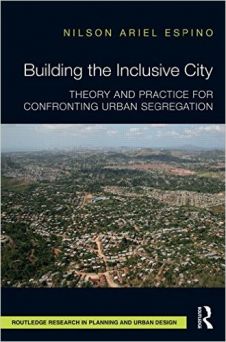Building the Inclusive City: Theory and Practice for Confronting Urban Segregation

Building the Inclusive City shows the socially exclusionary nature of much urban development. This is evident all over the world: in low-income countries, where the poor are excluded in the name of “modernization”, as well as in high-income countries, where the poor are excluded in the name of “order”. Pro-rich development leads to greater uniformity across the world’s cities, as the same kinds of office buildings, shopping malls and high-end residences pop up again and again.
The book mentions some potential benefits of urban segregation, such as the development of voluntary ethnic enclaves that are comforting to recent immigrants and preserve diversity across a city. However, these are clearly outweighed by the drawbacks of involuntary segregation. Espino’s vision is of inclusive urbanism, in which different social groups mix and have equal opportunities to participate. There are many socio-spatial obstacles to inclusive urbanism. Being pushed out to the city’s fringes, and facing long commuting times and limited economic opportunities as a result, is one. Feeling unsafe in your own neighbourhood is another.
The book’s first half is more theoretical. From anthropological and historical perspectives, it explores the nature of social roles and power, which lead to differentiation. For instance, wealth has traditionally been used to separate the residence and the work space, and in general to emphasize distinctions between areas – the sidewalk, the garden, etc. In lower-income areas, as in many Southern cities today, flexibility is more important than neat separations: a family may do manual work in its main room, makeshift spaces may be added to houses to allow room for extended family, and no space is designated as being exclusively for leisure. Despite accounting for a large proportion of the globe’s population, this spatial model is often seen as undesirable. This attitude paves the way for a privileging of certain types of space – and the people who are likely to occupy them – over others.
Historically these divisions have been situated along the lines of ethnicity, occupation and/or class. They have allowed for spatial location to be a determinant of social status in cities, especially with the rise of suburbanization. Even more than “suburb”, the heavy weight carried by the term “slum” shows how intimately linked location and social judgements are.
The book’s second half is more practical, and features descriptions of inclusive urban practices. Espino points out that it is unrealistic to expect market forces to produce inclusive cities. He therefore describes cases where governments have stepped in to reduce exclusion, as well as the criticisms of these. This has happened in European cities in the form of public housing, of course. To supplement or replace public housing, authorities have turned to land zoning (to allocate land to affordable housing), inclusionary legislation (requiring developers to provide a proportion of affordable housing), and land banking (purchasing land outright). They have also attempted to desegregate existing areas of exclusion, for instance by facilitating the relocation of low-income residents to mixed-income areas. And in some places, they have become more receptive to the work of squatter households and organizations in building and upgrading their own sites.
More specifically, Espino provides case studies of more responsible inclusive urbanism. One relates to the Casco Antiguo waterfront in Panama City, which was renovated to increase tourism. The planning incorporated the low-income population that lived along the waterfront, under a policy of zero evictions. Any new facilities for small and informal vendors were designed to be at least as large as the current ones. The result was a revamped area that was more secure, attractive and profitable, and that had not involved any displacement. Espino points to this as an example of urban development that can benefit mixed classes.
Further reading:
Beall, Jo (2002), “Globalization and social exclusion in cities: framing the debate with lessons from Africa and Asia”, Environment and Urbanization Vol 14, No 1, pages 41–51, available at http://eau.sagepub.com/content/14/1/41.abstract.
Budds, Jessica, Paulo Teixeira and SEHAB (2005), “Ensuring the right to the city: pro-poor housing, urban development and tenure legalization in São Paulo, Brazil”, Environment and Urbanization Vol 17, No 1, pages 89–114, available at http://eau.sagepub.com/content/17/1/89.abstract.
Muller, Anna and Diana Mitlin (2007), “Securing inclusion: strategies for community empowerment and state redistribution”, Environment and Urbanization Vol 19, No 2, pages 425–439, available at http://eau.sagepub.com/content/19/2/425.abstract.
Book note prepared by Christine Ro
Search the Book notes database
Our Book notes database contains details and summaries of all the publications included in Book notes since 1993 - with details on how to obtain/download.
Use the search form above, or visit the Book notes landing page for more options and latest content.
For a searchable database for papers in Environment and Urbanization, go to http://eau.sagepub.com/

